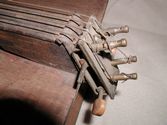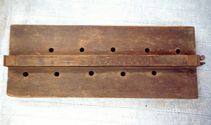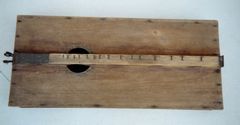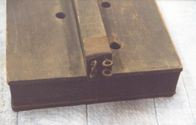The Tennessee Music Box – “A Dulcimer By Any Other Name”
Question: When is a dulcimer not a dulcimer?
Answer: When it is a Tennessee Music Box.
There are those who classify the Tennessee Music Box as an entirely different instrument than the Appalachian Mountain Dulcimer. But others point out the many similarities and assert that a Tennessee Music Box is really just a dulcimer by another name.
Both mountain dulcimers and Tennessee Music Boxes belong to a family of stringed instruments classified as fretted zithers. A zither is a type of instrument where the fretboard or strings run along the entire length of the instrument instead of extending beyond the body as with a guitar, mandolin or numerous other stringed instruments. Zithers date back to early recorded history and exist in a wide variety of shapes, sizes and string configurations.
The mountain dulcimer is generally thought to have evolved primarily from a German style zither called a scheitholt. It is believed that Pennsylvania’s German immigrants introduced the scheitholt into the Appalachian Mountains where enterprising mountaineers modified and developed it into the various forms and shapes of the American Appalachian Mountain Dulcimer.
A "Modernized" Tennessee Music Box by
Ron Gibson Dulcimers
As the dulcimer evolved, the shape changed so that particular shapes became associated with certain areas of the Appalachians. For instance,
Eastern Kentucky’s
Uncle Ed Thomas developed a small hourglass shape that is still widely copied. In the border area around West Virginia,
East Kentucky and Virginia, a larger
hourglass dulcimer gained popularity. In Virginia a teardrop shaped dulcimer came to prominence, which
was likely heavily influenced by the builder John Scales.
The Galax Virginia area produced an oval shaped dulcimer that is so tied to the region
that it is known as the Galax dulcimer and rarely made outside the region
even today. But in middle Tennessee a slightly different version of the
dulcimer developed although it was nearly lost to history – the Tennessee Music Box.
The Tennessee Music Box is aptly named, since it is essentially a large, rectangular wooden box with four strings. Like most early dulcimers, these were utilitarian instruments roughly crafted from available materials. The soundbox was constructed from any of the common hardwoods of the Appalachians, which include Poplar, Oak, Maple, and Chestnut. These hardwood slabs could be as thick as ½ inch and were glued and nailed together. The typical dimensions of the soundbox are 10 to 14 inches wide and 28 inches long with a body depth between three and four inches. But despite the crude construction and thickness of the soundboard, the TMB produces a loud, sweet, deep tone.
One characteristic feature of the TMB usually not found on other dulcimers is the metal plate on each end of the fretboard. This metal plate extends into the strumming area and was used to provide support for the eye screw tuning keys as well as to protect the wood from cracking or splitting. Interestingly, the eye screw tuning keys are located at the strumming end of the TMB instead of the opposite end as with other instruments. These reportedly hold a tune remarkably well.
The TMB’s fretboard is slightly larger than on most dulcimers. The 1½” width is common, but the 1½” height is rarely found on a mountain dulcimer. Another difference is that the TMB fretboard is never hollowed as is usually the case with a mountain dulcimer. The normal scale length associated with a music box is 26½” with the 15 frets being made of fence staples and extending only under the first string. This feature is also common to early mountain dulcimers. The TMB’s soundholes are commonly simple ¾” holes equally spaced along the body of the instrument and placed close to the fretboard.
Music boxes were played and tuned much like mountain dulcimers – often with a noter and sometimes with a bow. The tuning probably varied from player to player much as it does with a dulcimer. But there is also significant evidence that many were played like a slide guitar. This is supported by oral history as well as the high string settings on some of the historical instruments and the lack of wear on the fretboard. To my knowledge, no mountain dulcimers were routinely played in this style – at least not in significant numbers to gain attention.
The TMB appears to have been built only between the 1870’s and 1940’s and almost exclusively in middle Tennessee, but because of the sturdy construction many instruments have survived. Unfortunately, the TMB never gained the wider acceptance of the Appalachian Mountain dulcimer. This is likely due to its crude construction, rustic looks and the lack of the Elizabethan romance normally accorded to the mountain dulcimer.
So is a TMB so different from a mountain dulcimer that it should be designated as a totally different instrument? Many assert that an instrument is only a TMB if it has the large size, metal plates, small soundholes and eye screw tuners of the originals. But there are few dulcimers made today that do not have significant changes as compared to their ancestors. Geared tuners, mother of pearl inlays, machined frets instead of nails, wild shapes and exotic woods all represent a change, and in some cases an improvement over traditional dulcimers. Yet, these are still called Appalachian Mountain Dulcimers. However, many people view the TMB with a stricter interpretation of what is acceptable to change and still retain the TMB designation.
On one hand, I see much value in retaining the traditional and historical integrity of this venerable instrument. On the other hand, if the TMB is to be popular and not relegated to history, it must be a functional and usable musical instrument. So when I make a large-bodied rectangular dulcimer with geared tuners and modern soundholes, I call it a Box Dulcimer/Tennessee Music Box and state, “Of course, the buyer can call it whatever they like.” In the end, Shakesphere was probably correct when he wrote, “A rose by any other name would smell as sweet.” After all, isn’t a cello really just a great big fiddle? Yet no one would call it a violin. The debate rages on….




